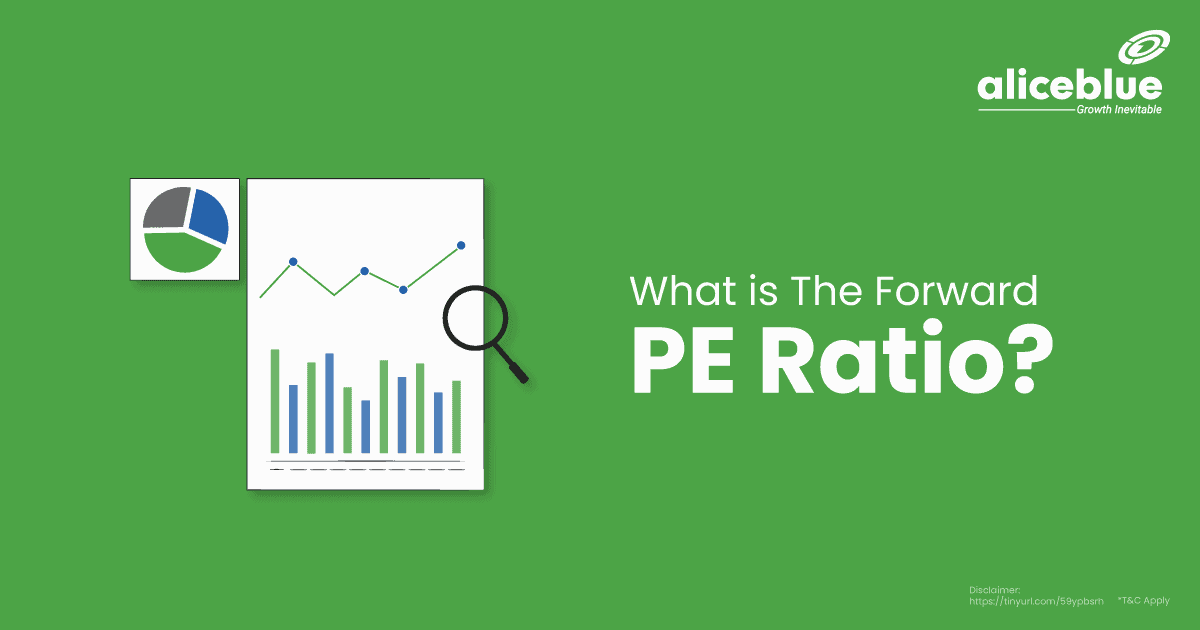The Forward Price-to-Earnings (PE) Ratio is a valuation metric predicting a company’s future earnings. It divides the current stock price by estimated future earnings per share. Unlike traditional PE, which uses past earnings, Forward PE provides an insight into a company’s future profitability.
Content ID:
- Forward P/E Ratio
- How to Find Forward P/E Ratio? – Forward P/E Ratio Formula
- How to Use Forward P/E Ratio?
- What Is a Good Forward P/E Ratio?
- Trailing P/E vs Forward P/E
- What Is The Forward PE Ratio? – Quick Summary
- Forward P/E Ratio – FAQs
Forward P/E Ratio
The Forward PE Ratio is a financial measure comparing a company’s current share price to its expected earnings per share. It forecasts a company’s earnings potential, differing from standard PE by focusing on future rather than past earnings, offering a forward-looking assessment of value.
The Forward PE Ratio evaluates a company’s stock price relative to its anticipated earnings. It divides the current market price of a stock by its estimated future earnings per share, offering a glimpse into expected profitability.
This ratio serves as a forward-looking indicator, contrasting with the traditional PE Ratio, which is based on historical earnings. It helps investors assess whether a stock is overvalued or undervalued, considering the company’s future earnings potential.
Example: Consider a company with a current stock price of ₹100 and expected annual earnings per share of ₹5. The Forward PE Ratio is 20 (₹100 divided by ₹5), indicating future earnings valuation.

How to Find Forward P/E Ratio? – Forward P/E Ratio Formula
To find the Forward PE Ratio, first obtain a company’s expected future earnings per share (EPS) from financial forecasts or analyst estimates. Then, divide the company’s current stock price by this anticipated EPS. The result is the Forward PE Ratio.
Forward PE Ratio= Current Stock Price / Estimated Future Earnings Per Share (EPS)
How to Use Forward P/E Ratio?
Forward PE Ratio is used to compare a company’s current stock price to its expected earnings, providing insight into its valuation. A lower ratio may indicate undervaluation, while a higher ratio suggests overvaluation. Compare it with industry averages and historical ratios for context.
What Is a Good Forward P/E Ratio?
A “good” Forward PE Ratio varies by industry, market conditions, and company growth prospects. Generally, a lower ratio might suggest undervaluation, but context is key. Ratios should be compared against industry averages and historical norms, and aligned with individual investment strategies and risk tolerance.
Trailing P/E vs Forward P/E
The main difference between Trailing PE and Forward PE ratios is that trailing PE uses past earnings data, reflecting historical performance, whereas Forward PE relies on estimated future earnings, providing a projection of a company’s potential future profitability.
| Aspect | Trailing PE Ratio | Forward PE Ratio |
| Earnings Used | Based on the company’s past 12 months’ earnings | Uses projected or estimated earnings for the next 12 months |
| Focus | Historical performance | Future profitability and performance |
| Indication | Reflects what the company has already achieved | Indicates expectations and forecasts about future earnings |
| Market Perception | Can be influenced by past events that are no longer relevant | More dynamic, adjusts to future prospects and changes in business environment |
| Usefulness | Effective for analyzing past performance | Helpful in forecasting and making future investment decisions |

To understand the topic and get more information, please read the related stock market articles below.
What Is The Forward PE Ratio? – Quick Summary
- The Forward PE Ratio, a key financial indicator, assesses a stock’s current price against projected future earnings. This forward-looking metric contrasts with the traditional PE Ratio by emphasizing anticipated, not historical, earnings to gauge a company’s value.
- To calculate the Forward PE Ratio, acquire the company’s predicted future EPS from analyst projections or financial forecasts. Next, divide its present stock price by this future EPS. This calculation yields the Forward PE Ratio.
- The Forward PE Ratio compares a company’s current share price with projected earnings, offering a valuation perspective. A lower ratio hints at potential undervaluation, a higher one at possible overvaluation. Contextualize it against industry norms and past ratios for a comprehensive view.
- A suitable Forward PE Ratio is influenced by sector norms, market dynamics, and growth expectations. Generally, lower ratios can indicate undervaluation. However, it’s important to benchmark against industry trends, historical averages, and align with your investment objectives and risk preferences.
- The key difference between Trailing PE and Forward PE ratios lies in their earnings basis: Trailing PE assesses stock value using historical earnings, showing past performance, while Forward PE evaluates it against anticipated future earnings, forecasting potential profitability.
- Open free demat account with Alice Blue in 15 minutes today! Invest in Stocks, Mutual Funds, Bonds & IPOs for Free. Also, trade at just ₹ 15/order and save 33.33% brokerage on every order.
Forward P/E Ratio – FAQs
What is the forward PE Ratio?
The Forward PE Ratio is a financial metric that compares a company’s current stock price to its projected future earnings per share, offering an insight into the expected profitability and valuation of the company.
What is the forward PE Ratio example?
For example, if a company’s stock trades at ₹100 and its expected earnings per share next year are ₹10, the Forward PE Ratio is 10 (₹100 divided by ₹10), indicating its future earnings valuation.
What Is a Good Price-to-Earnings Ratio?
A good Price-to-Earnings (PE) Ratio varies by industry and market conditions. Generally, a lower PE suggests undervaluation, but it’s important to compare against industry norms and consider growth potential for a meaningful assessment.
What is the PE ratio in the share market?
In the share market, the PE Ratio measures a company’s current share price relative to its per-share earnings, providing a valuation metric to compare stock prices against the company’s earnings performance.
What is the difference between PE and forward PE?
The key distinction is that PE ratio assesses a company’s historical earnings for past performance evaluation, while forward PE looks at predicted future earnings, providing a forecast of the company’s potential profitability.
We hope that you are clear about the topic. But there is more to learn and explore when it comes to the stock market, commodity and hence we bring you the important topics and areas that you should know:






